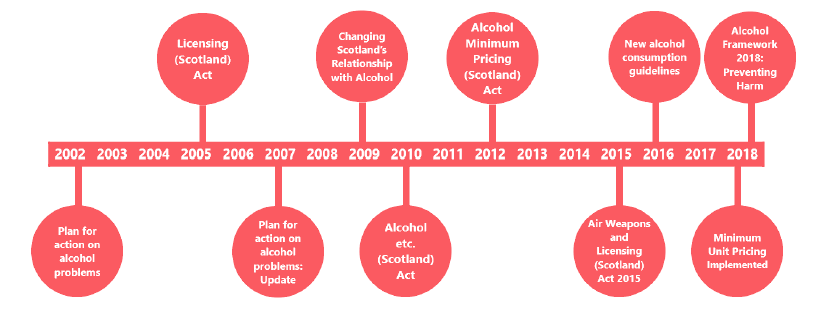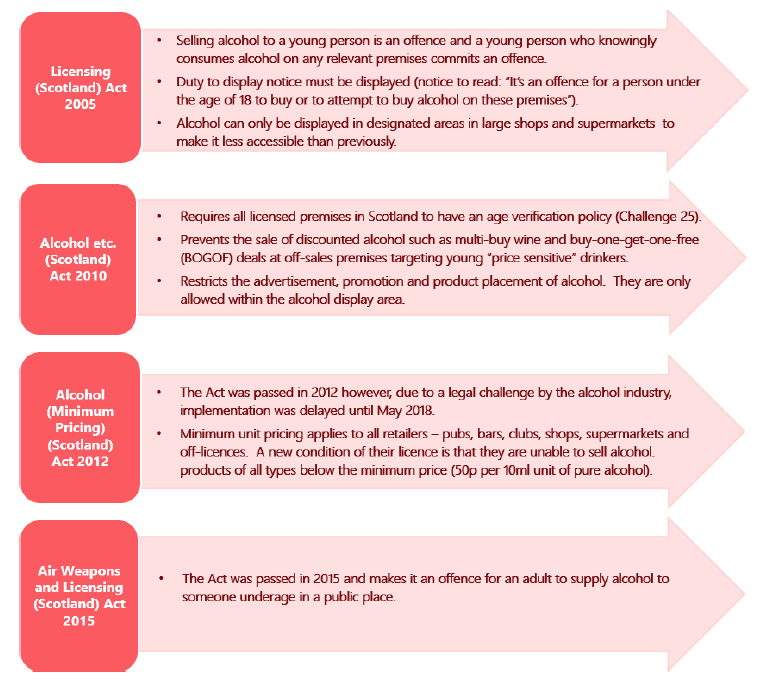Scottish Schools Adolescent Lifestyle and Substance Use Survey (SALSUS): alcohol report 2018
Findings on alcohol from the 2018 wave of the Scottish Schools Adolescent Lifestyle and Substance Use Survey (SALSUS).
This document is part of a collection
1 Introduction and background
This report presents the alcohol findings from the 2018 wave of the Scottish Schools Adolescent Lifestyle and Substance Use Survey (SALSUS). The research was commissioned by the Scottish Government and carried out by Ipsos MORI Scotland.
Survey background
SALSUS is a continuation of a long established series of national surveys on smoking, drinking and drug use. These were carried out jointly in Scotland and England between 1982 and 2000, to provide a national picture of young peoples' smoking (from 1982), drinking (from 1990), and drug use (from 1998) within the context of other lifestyle, health and social factors. Since 2002, Scotland has developed its own, more tailored survey known as SALSUS.
Survey purpose
SALSUS informs progress towards Scottish Government policies to reduce the harms from smoking, drinking and drug use among children and young people.
The survey series also provides local prevalence rates for smoking, drinking and drug use across Alcohol and Drug Partnerships (ADPs), local authorities and NHS Boards.
Policy background
The level of harms from alcohol in Scotland is high in comparison to the rest of the UK and internationally. Reducing the harms caused by alcohol is one of Scotland's six public health priorities[2](along with reducing harms from smoking and drug use). Action has been taken to reduce the harms by successive Scottish Governments as outlined in Figure 1.1.
In 2009, a whole population approach was taken, and the then national alcohol strategy[3], Changing Scotland's Relationship with Alcohol: A Framework for Action, was published. This adopted the World Health Organization's prevention measures for alcohol of affordability, availability, attractiveness. Under this strategy, the Scottish Government's actions included legislating to ban irresponsible promotions; introduction of a multi-buy discount ban; introduction of an age verification policy such as Challenge 25; and introduction of minimum unit pricing.
Figure 1.1 Scottish alcohol policy timeline (2002-2016)

Alcohol Framework 2018: Preventing Harm
In November 2018, a refreshed Alcohol Framework[4] was published, which builds on the previous Framework and has three central themes:
1. reducing consumption
2. positive attitudes, positive choices
3. supporting families and communities
The fourth theme in the previous Framework of 'improved treatment and support' now sits within the 2018 drug and alcohol treatment strategy[5].
There are two consistent threads running through the Framework: reduce health inequalities, and protect children and young people. For the latter, this means that all work on preventing underage drinking, marketing and advertising, education in schools, positive alternative opportunities and safer communities, and preventing alcohol-related violence and crime all aim to protect children and young people. Action 1 in the Framework states "We will put the voices of children and young people at the heart of developing preventative measures on alcohol." In practice, this means that measures will be developed with children and young people and not imposed upon them. The views of children and young people will be sought to help shape the policy.
Key actions in the Framework include:
- Evaluating minimum unit pricing and reviewing the price after 1 May 2020;
- Pressing the UK Government to impose a 9pm watershed for alcohol advertising on TV as well as restrictions on cinema advertising;
- Consulting on the suitability of restrictions on alcohol marketing to protect children and young people;
- Running a social marketing campaign on the alcohol low risk drinking guidelines of 14 units per week – the first phase of the count14 campaign ran in 2019;
- Pressing alcohol producers to put health information on labels.
Key legislation
Current key policies relating to alcohol include: the Licensing (Scotland) Act 2005, the Alcohol etc. (Scotland) Act 2010, the Alcohol (Minimum Pricing) (Scotland) Act 2012 and the Air Weapons and Licensing (Scotland) Act 2015. Figure 1.2 outlines the key points from each that are relevant to young people.
Figure 1.2 Key legislative measures affecting young people

Further information about policy relating to alcohol is available at:
- NHS Health Scotland:
http://www.healthscotland.com/topics/health/alcohol/index.aspx - Scottish Government:
https://www.gov.scot/policies/alcohol-and-drugs/
Methods
SALSUS is a self-completion survey administered by teachers in a mixed ability class, under exam conditions. In the past the survey has been completed on paper, but in 2018 schools were given the choice to complete the survey online or on paper.
A random, nationally representative sample of S2 and S4 pupils in Scottish schools was drawn with classes as the primary sampling unit. All local authority and independent schools in Scotland were eligible for inclusion in the sample, with the exception of special schools.
Fieldwork was completed between October 2018 and April 2019. A total of 12,558 S2 and 10,807 S4 pupils responded (including schools that took part in the Realigning Children's Service Survey).
The overall response rate was 52% (excludes schools that took part in the Realigning Children's Services Survey and Glasgow state schools).
Data was weighted by local authority, age, sex, school sector (state/independent), school denomination and by urban/rural classification.
Throughout the report pupils in S2 are referred to as '13 year olds' and S4 pupils are referred to as '15 year olds' for ease. It should be borne in mind that some pupils within these categories may be slightly older or younger.
Some pupils did not answer each question. Where answers are missing, these have been excluded from the analysis and so charts and tables that describe the same population may have varying bases. When differences between estimates are specifically commented on in the report, these differences are statistically significant to the level of 0.05.
Percentages may not add up to 100% due to rounding.
For full details of the methodology, please see the SALSUS 2018 Technical Report[6].
Finally, it is important to note, that while there are associations between many of the behaviours explored in this report, conclusions about causality cannot be drawn.
Changes to the questionnaire
No alterations were made to the alcohol questions for 2018, so they are the same as in the 2015 survey. For further details on other question changes and survey methodology see the SALSUS 2018 Technical Report and the full 2018 questionnaire[7].
Contact
Email: salsus@gov.scot
There is a problem
Thanks for your feedback